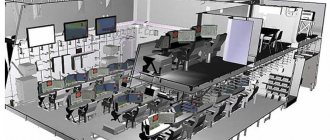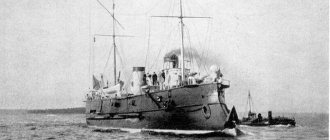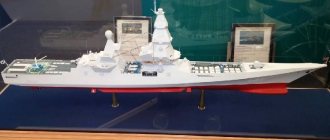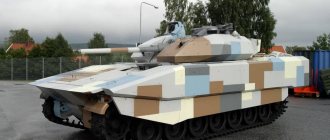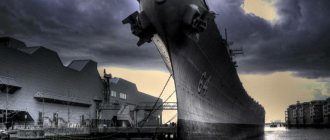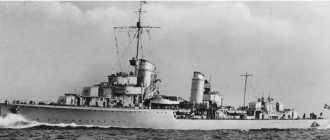History of creation
The time of the Cold War consists of changes, confrontations and warmings. By the late 1960s, the governments of the Soviet Union and the United States agreed that the risk of nuclear war could lead to disastrous consequences for both sides and the world in general. Therefore, since the early 1970s, the emphasis has been more concentrated on discharging nuclear weapons. However, the rivalry did not end there, but simply moved from weapons of mass destruction to conventional ones.
Design
From the navy's point of view, the US wanted to maintain its advantage. But the destroyers built in the 1970s, the Spruance, did not meet the standards of the changed policy. The main disadvantage of the Spruance destroyers is the lack of missile control. After the advent of the guided missile system, the Navy Command decided to create a new type of destroyers to complement the Spruance destroyers and replace the old ones. The first project of a destroyer with a guided missile system appeared in 1980. This project was supposed to give America a significant advantage over the USSR Navy in terms of destroyers. Seven shipbuilding companies proposed their projects for a new type of ship. In 1983, only 3 companies remained, and in 1985, 2 shipyards won the construction tender: Bath Iron Works and Ingalls Shipbuilding.
Construction
This type of destroyer was named “Arleigh Burke” by the ex-chief of naval operations (Eisenhower and Kennedy administrations) Admiral Arleigh Burke, who proved himself to be a true leader and strategist during the Second World War and the Korean Wars. The first ship also received the admiral's name.
The destroyer "Arleigh Burke" was built in a year and was launched into the water in 1989 with the participation of the ex-leader's wife (the complete construction process of the ship took a little more than a year), and entered service with the US Navy on June 4, 1991 ( I was under testing for 2 years). The admiral himself was present at the ceremony.
After successful tests of the destroyer, which took place from September 1, 1989 to June 1, 1991, mass construction of this type of combat vessel was approved. Bath Iron Works and Ingalls Shipbuilding received an order for another twenty ships of the Arleigh Burke class.
Like all military equipment, Arleigh Burke is not a cheap pleasure. On average, the price of each ship cost America a little more than 1 billion. dollars (1.1 billion in 1985, 1.25 billion in 2009). Moreover, there are costs for maintaining ships. Every 2 years, destroyers undergo planned repairs, where from 20 to 25 million dollars are spent on each. If we consider that the American fleet consists of 62 Arleigh Burkes, then every 2 years an average of 1.4 billion is spent on repairs. dollars.
Instead of "Zamvolt" and "Arleigh Burke"
Today, the US Navy is the most powerful in the world: this applies, in particular, to its fleet of guided missile destroyers The Americans built 70 (!) Arleigh Burke-class destroyers. The ship is constantly being improved, making it more and more dangerous for opponents. US ambitions are growing.
Theoretically, China can overtake the Americans, especially since the Chinese shipbuilding pipeline is operating at full capacity. Beijing has already commissioned about 20 Type 052D destroyers (they have been building since 2012), as well as four, without exaggeration, giant Type 055 destroyers (total displacement is 13,000 tons), which are sometimes called “cruisers” in the press.
Chinese forces are not enough to pose a real challenge to the Americans.
At the same time, the Americans themselves are experiencing serious difficulties.
The real symbol here was the destroyer Zamvolt , which can rightfully be called “the most unsuccessful ship in the history of the US Navy .”
Initially, the States wanted to build 32 of these ships. Later this number was reduced to 24, then to seven and finally to three units.
The real talk of the town was the armament of the Zamvolt, but this is a separate story, very sad for the US Navy.
general characteristics
The latest model of the destroyer has a length of 153.9 m, a width of 20.1 m, a displacement of 8,900 tons, a power of 108,000 hp, a maximum speed of 32 knots, and a range of 4,400 miles (at an optimal speed of 20 knots).
Design and General Data
The Arleigh Burke-class destroyers are slightly different from the Spruance in terms of technology, material, weapons and the hull itself.
The Arleigh Burke family is divided into 3 models (“I”, “II” and “IIA”). Each model is an indicator of modern technologies and weapons, as a result of which the destroyer was modernized, changed internally or externally. Therefore, to describe the design to you, we will analyze each of the models separately. We will examine topics related to general data and differences in the hull here, and we will examine the topic of weapons separately.
Model "I"
The construction of the building takes place according to a modular system, i.e. First, individual blocks are prepared, then they are assembled into one whole. This was facilitated by the design of the ship itself, which was designed using Stealth technology. The Arleigh Burke are the first destroyers built on the stealth principle. In this regard, the very concept of the ship consists of sharp corners and a minimum of unnecessary things on the open deck, which increases the scattering of radio waves. Moreover, ships of this type are equipped with a radio wave absorption system. The chimneys of a ship have a similar system for reducing heat waves. Hot air mixes with cold air before it leaves the pipe, thereby reducing their visibility on enemy thermal radars. Due to the innovations listed above, the Arleigh Burke has 2 times less visibility on radar and thermal radars than its predecessors, the Spruance. And the modular system made the construction of the building only 10-15 months.
According to general characteristics, the Arleigh Burke is a classic single-hull ship with an increased length along the waterline and a low-drawing hull. After the lessons learned by the allies (Great Britain) in the Falklands War, as well as incidents (fires on ships) that occurred in the US Navy, the ship's hull became steel again for the first time in a long time (before that it was aluminum). The bow of the new hull has full contours, and the branches of the bow frame have a small camber. Despite the fact that because of this, the destroyer may have lost a little in speed and range, it gained better stability (the pitching range decreased) and seaworthiness.
Due to the danger of weapons of mass destruction, the design of the Arleigh Burke guided missile destroyer allows personnel to reach any part of the ship without going onto the open deck. The destroyer consists of 13 compartments, 3 decks (2 internal and 1 open) and has a double bottom (increases the quality of survivability).
A total of 21 I-model destroyers were built.
Model "II"
In general, this model does not have any special changes from the first. Here is a list of all the innovations of the new model:
- Improved crew living conditions;
- Reduced fuel consumption due to minor changes to the nose;
- Reduced cavitation noise thanks to a new screw system;
- Increased metacentric height;
- Increased armor thickness.
In total, 7 destroyers of the II model were built.
Model "IIA"
The third model has significant changes both in the body and in the construction technology. First, the technology of connecting already saturated modules began to be used, which clearly simplified its construction. The length of the hull was increased by 1.37 m, the width remained the same. Due to this small change in length, they were able to install a full-fledged hangar for servicing the helicopter. Experts consider this one of the main changes in the new model because... the lack of a hangar compromised air mobility, submarine protection, reconnaissance and support capabilities if the helicopter failed. Accordingly, the ship's crew (the group servicing the helicopter) has increased. Moreover, satellite communications and the Internet appeared on the ship.
A total of 34 IIA model destroyers were built.
Next-Generation Guided-Missile Destroyer
The real replacement for the Arleigh Burke-class ships will be another destroyer.
The program was called DDG(X) or Next-Generation Guided-Missile Destroyer. It was the culmination of the Large Surface Combatant (LSC) initiative, which followed the cancellation of the CG(X) program, reductions in procurement of Zumwalt-class destroyers, and the possible need to replace existing destroyers and cruisers. LSC eventually morphed into DDG(X) with a program office created last June.
The US Navy showed what the new ship will (could) look like in January of this year.
De facto, this is just one of the possible ship configurations. Nevertheless, it allows us to draw some conclusions.
We are talking about an extremely large ship (exact dimensions not specified), which will have extensive anti-submarine and strike capabilities, as well as powerful directed energy weapons.
The DDG(X) concept itself and some details of its design were presented at the Surface Navy Association National Symposium, which was held in Arlington (Virginia, USA). The Americans are not abandoning the production of the Arleigh Burke destroyers, but they consider the ship's capabilities to be insufficient in terms of its ability to continue to receive updates and improvements in the future. This is inextricably linked with the hypersonic weapons that the United States is now creating.
As it became known earlier, the problematic Zamvolt will be the first of the ships with which it will be equipped. At the same time, as noted above, there are only three such destroyers, and ships like the Arleigh Burke may not have enough internal space to become real platforms for launching hypersonic weapons.
First of all, the concept of DDG(X) attracts attention.
Apparently, the United States has finally abandoned the idea of getting a “stealth” fleet. The new ship is much more like the Arleigh Burke than the Zamvolt.
The Navy itself has said it takes an "evolutionary" approach to design. This means it draws on technologies proven on the Ticonderoga-class cruisers, as well as in the modernization of the Arleigh Burke-class destroyers.
The ship is initially created to meet the requirements of the Asia-Pacific region with an eye to operations in gigantic maritime spaces.
In addition, it will be able to operate more effectively in the Arctic region than its predecessors.
The ship's cruising range will increase by about 50 percent compared to its predecessor. This is expected to be achieved, at least in part, by improving fuel efficiency, as well as reducing fuel consumption by at least 25 percent.
Armament of the destroyer Arleigh Burke
There are many different weapons systems and installations on board the main destroyer of the US Navy, but of all, I want to highlight the Aegis control system, with the advent of which the role of destroyers in the armed forces system has radically changed. Therefore, of all the weapons, the first thing we will do is disassemble it.
Aegis Control System
With the advent of Aegis control system technology, destroyers were able to independently destroy any targets in the air, on land or water. "Aegis" is a multidisciplinary combat information and control system, which is responsible for integrating shipboard information, control and destruction systems. In other words, the Aegis system is a central bank of all data that comes from many ship subsystems, thanks to which a clear picture of actions appears. Of course, the bank is important for almost all systems/subsystems, but especially for the ship's weapons system.
However, according to some experts, this multifunctional “miracle” has its drawbacks. They are mainly associated with the low-blind AN/SPY-1 radar, which does not respond well to low-flying targets.
Artillery
The main artillery piece of the Arleigh Burke family is the 127 mm Mark 45 class artillery mount. At different periods of time, these installations had different characteristics. These days, a 127mm Mark45 Mod 4 class mount is used, which allows it to fire 20 rounds per minute at a maximum distance of 37 km. (high-explosive fragmentation) up to 115 km. (“ERGM” and “BTERM”) depending on the class of the projectile.
Mark 45 Mod 4
Flak
Anti-aircraft artillery has been modernized the most. While in “I” and “II” the models had 6-barreled Vulcan-Phalanx complexes, now the destroyers are equipped with 24 RIM-7 Sea Sparrows. The main weapons are Standard-3 cruise missiles with a range of up to 500 km. and “Tactical Tamahawk” with a maximum engagement range of up to 2500 km. Each destroyer carries up to 56 Tamahawk cruise missiles.
Complex "Vulcan-Phalanx"
Mine and torpedo weapons
The main anti-submarine safety system is LAMPS-III class helicopters. Onboard weapons include the RUM-39 VL-Asroc class PLUR and the Mk32 torpedo system. On the latest model of the destroyer, the Harpoon-class anti-ship missiles were withdrawn from service due to financial aspects.
Aviation weapons
After the modernization of the hull and the appearance of a helicopter hangar on the deck, it became possible to maintain 2 SH-60 Sea Hawk class helicopters. These helicopters can fire Hellfire and Penguin air-to-surface missiles, Mark-46/51 submarine-launched torpedoes, and provide air support to allied forces.
Destroyers "Orly Burke". Record holders with rocket weapons
In June 2011, the US Navy announced its plans for the future of US Navy destroyers. Promising Zumwalt-class destroyers turned out to be too expensive for mass production, so it was decided to leave the Arleigh Burk project as the main Navy destroyer. In addition, the fleet will be replenished with ships of the Orly Burke type until the early thirties of this century. During this time, American shipyards will assemble two dozen destroyers. Based on the usual service life of ships for the United States Navy, it can be assumed that the last ship of the Orly Burke class will be withdrawn from the fleet only in the seventies of this century. Apparently, the US Navy command has its own considerations that allow these destroyers to be included in such a distant future.
To ensure an advantage over the USSR Navy in the mid-70s, American sailors wished to receive destroyers of a new project. The recently appeared Spruens, although they were modern ships, still did not have much prospects and required, if not replacement, then at least a serious addition. In addition to this, Spruance class destroyers, despite the available weapons, were listed in official documents as ordinary destroyers, and the time and situation required full-fledged guided missile destroyers (with guided missile weapons). Work on shaping the appearance of the new ship and the technical specifications for it took several years, and the development competition began only in 1980. It took seven shipbuilding companies about three years to create competitive preliminary designs, after which three competitors remained: Bath Iron Works, Ingalls Shipbuilding and Todd Shipyard. The third company was never able to gain the “attention” of the competition commission, which is why the construction of the first two ships of the new project was entrusted to Bath Iron Works and Ingalls Shipbuilding, respectively. The project, as well as its lead ship, was named after Admiral Orly Albert Burke, who commanded various destroyer formations for most of the Second World War. The contract with Bath Iron Works for $322 million was signed in April '85. However, the total cost of the lead destroyer turned out to be several times higher. Taking into account all electronic equipment, weapons, etc. it cost the Pentagon 1.1 billion.
Construction of the USS Arleigh Burke (DDG-51) began in late 1988, and it entered service on Independence Day 1991. Subsequently, two dozen more similar ships were built by two shipyards - Bath Iron Works and Ingalls Shipbuilding. The first two dozen ships of the new project were made in accordance with the first version of the project, which was named Flight I. However, soon after the start of construction of the lead project of the first series, American shipbuilders began modernization. As a result, the destroyer USS Mahan, ordered back in 1992, was completed as the first ship of the second series. The construction of destroyers of the Flight II version was on a more modest scale: only seven ships. It is alleged that the small second series was initially considered as a transitional link from the first to the third. This is what happened, but contrary to logic, the new version of the project did not have a three in the index, but the designation IIA. This line turned out to be the most numerous. At the moment, 34 Orly Burke series IIA destroyers have been built and their construction continues. The total number of ships according to the old plans was supposed to be 75 units, but so far only 62 are ready. Most likely, those 24 destroyers that will be ordered later will be made according to the next version of the project.
All existing series of ships - I, II and IIA - have only minor differences in design. They are caused by the peculiarities of the installed equipment and the peculiarities of the operation of helicopters. The rest of the design is similar. The Orly Burke of all three series are single-hulled ships with a long forecastle. It is noteworthy that the vast majority of the ship's hull parts are made of high-strength steel. The fact is that after the Second World War, American shipbuilders began to actively use aluminum parts in the design of ships of this class. In engineering terms, this was a good start, but the experience of battles involving aluminum ships forced a return to steel. Only some parts, such as masts, are made from aluminum on the Orly Burke destroyers. The low-drawing hull has a relatively small frame camber in the bow and a relatively wide middle part. This hull shape slightly increases water resistance, but improves stability and reduces pitching. On ships of the IIA series, a bow bulb was added, which compensated for the deterioration in flow due to the peculiarities of the hull contours. Waterproof bulkheads divide the internal volume of the hull into 13 compartments. Interestingly, the lower decks have a layout that allows you to move around the ship without restrictions without going to the upper deck. This was done so that the crew would not be at risk in the event of the enemy using weapons of mass destruction. In addition to specially designed interior spaces, the crew is protected from chemical, biological and nuclear weapons by a special ventilation system with multiple filtration of air taken from outside.
The Orly Burke became the first American destroyers whose hull and superstructure were made using stealth technologies. To reduce radar signature, the outer surface of the ship's superstructure consists of several large, even panels mated at sharp angles, which leads to noticeable scattering of radio waves. Chimney casings are made in a similar way. In addition, before being released, the exhaust from the power plant passes through a special mixing chamber, where it is mixed with atmospheric air and cooled. As a result, Orly Burke-class ships have almost half the radar and thermal signature of their Spruance-class predecessors. The use of large parts that help reduce visibility, among other things, made it possible to make the ship's design modular. Thanks to this, 10-15 weeks pass from the keel of the ship to its launching.
The twin-shaft power plant of the Orly Burke destroyers of all series includes four LM2500 gas turbine engines manufactured by General Electric. Each engine is equipped with a thermal insulation circuit, which reduces fuel consumption by almost a quarter, and is mounted on shock-absorbing mounts that reduce noise. The entire power plant of the ship is a single module, which, if necessary, can be dismantled entirely. The maximum possible power of the power plant is in the range of 100-105 thousand horsepower. Destroyers of all series have three Allison 2500 gas turbine engines as backup engines. The power of the main and backup engines is transmitted to two shafts that rotate five-blade variable-pitch propellers.
Destroyers of the Orly Burke project are capable of speeds of up to 32 knots, but their maximum cruising range is achieved at an economic speed of 20 knots. In this case, destroyers of the first series can travel up to 4,400 nautical miles, and ships of series II and IIA - half a thousand miles more. At the same time, some American sources claim that reducing the speed to 18 knots can increase the cruising range to six thousand miles. However, there are some doubts about this.
The first 28 ships of the Orly Burke class (series I and II) had a crew of 320-350 people: 22-25 officers and 300-330 sailors, warrant officers, etc. The difference in numbers was due to some differences in weapons and the number of helicopters. On the IIA series ships, the required number of crew in a number of services was revised and a maintenance group was added for two helicopters. All this led to an increase in the crew to 380 people (32 officers). The Americans especially note the fact that designers and ergonomic specialists participated in the layout of the living quarters of the Orly Burke ships. Thanks to this, with an area of about four square meters per person, it was possible to create all the necessary conditions for normal living.
The weapons of the Orly Burke destroyers include many systems, but its basis is the Aegis control system (pronounced “Aegis”). This multifunctional combat information and control system (CIUS) combines a whole range of detection, control and destruction means. Aegis includes a multifunctional phased array radar, air and surface target detection radar, electronic warfare equipment, communications equipment, etc. In addition, the Aegis has a number of subsystems for outputting information, transmitting data to other ships and direct weapons control systems.
The basis of the weapons of the Orly Burke destroyers are missiles of various types. In the bow and stern of ships of all series there are universal Mk 41 silo launchers. On ships of series I and II, the bow and stern launchers have 30 and 60 cells, respectively. On the IIA series, the number of cells increased to 32 and 64. One cell can accommodate a transport and launch container with a BGM-109 Tomahawk cruise missile, an SM-2 or SM-3 anti-aircraft missile, or a block of four containers with RIM-7 Sea Sparrow anti-aircraft missiles . The launcher's equipment makes it possible to simultaneously prepare 16 missiles of various types for launch and launch them at a rate of one missile per second. In addition to launchers, the Mk 41 has several cranes for loading TPKs with missiles. However, the peculiarities of the crane equipment and the design of the destroyer do not allow reloading Tomahawk or SM-2/3 missiles from supply ships. Loading of such weapons is possible only at the base. This drawback is compensated by the flexibility of the weapon range: if the ship is to attack ground targets, then it will receive Tomahawks; if the ship will perform air defense functions, it will be loaded with Sea Sparrow or SM-2/3.
The “main caliber” of artillery weapons of destroyers is the 127-mm Mk 45 installation. At the same time, the Mk 45 Mod was installed on the first 30 copies of the Orly Burke. 2, on the rest - Mk 45 Mod. 4. An installation with bulletproof armor can aim a 127-mm rifled gun within the range from -15° to +65° vertically and in almost all directions horizontally, of course, with the exception of the sector covered by the ship’s superstructure. The rate of fire of the Mk 45 with conventional projectiles reaches 20 rounds per minute, and in the case of guided ammunition it drops by half. The maximum firing range of an unguided projectile is the Mk 45 mod. 4 is 35-38 kilometers. When using an ERGM guided active-missile projectile, this figure increases to 115 kilometers. The artillery cellar of the Orly Burke destroyers can accommodate 680 rounds of various types of ammunition. It takes about 15-16 hours to load this entire number of shells.
The Orly Burke anti-aircraft artillery can be equipped with various types of weapons. On ships of series I and II, as well as on the first few destroyers of series IIA, six-barreled 20-mm Mk 15 Phalanx CIWS anti-aircraft guns with a rate of fire of up to 3000 rounds per minute were installed. Fewer ships were equipped with 25 mm Bushmaster automatic cannons, and almost all Orly Burke are equipped with several (three to six) Browning M2HB heavy machine guns. Despite their original purpose, the M2HB and Bushmaster are ineffective for air defense. Therefore, they are used only for training personnel and firing at small targets, such as light boats and motor boats.
To destroy more serious surface targets, destroyers of all three series have two built-in Mk 32 torpedo tubes with a total ammunition load of six torpedoes. These could be Mk 46 or Mk 50. When creating the Orly Burke destroyers, the main emphasis was on missile weapons, so reloading the torpedo tubes by the crew after shooting all six torpedoes is not provided. In early versions of the project, engineers considered the possibility of using depth charges on the Orly Burke, but even this tactical and technical solution did not reach Flight I.
One SH-60 helicopter could be based on the deck of ships of the first and second series. Next to the landing site there was a kerosene tank and a small “warehouse” with weapons - nine Mk 46 torpedoes. On helicopters intended for deployment on the Orly Burke destroyers, the LAMPS-3 anti-submarine system is installed, integrated into the general Aegis BIUS. Due to the limited capacity of the ships of the first two series, they did not have any means of maintaining or repairing the helicopter, other than those available on board. Thus, any more or less serious breakdowns resulted in the ship being left without rotorcraft “eyes.” When creating the IIA version of the project, these shortcomings were taken into account and the shipbuilders made a special helicopter hangar in the aft part of the ship’s hull, thanks to which the destroyer’s aviation group doubled. This is what required the introduction of an aircraft maintenance group into the crew. Engineers also increased the size of the arsenal for helicopter weapons: on the Orly Burke Series IIA it can accommodate up to 40 torpedoes, air-to-ground missiles of various types and even several MANPADS.
Destroyers of the Orly Burke class have participated in several military conflicts, starting almost from the very beginning of their service. Iraq in 1996, 1998 and 2003, Yugoslavia in 1999 and several other operations. Due to their large number (sixty ships are currently in service), these destroyers participate in almost every campaign of the American Navy. However, in Russia these ships are better known for the “mission” of the destroyer USS McFaul (DDG-74), which it carried out in August 2008. Let us remember that then, a few days after the end of the notorious “Three Eight War,” this ship brought 55 tons of humanitarian cargo to the Georgian port of Batumi.
In addition to combat successes and an interesting design, the Orly Burke destroyers are, in some way, record holders in the American fleet. The fact is that with a total displacement of about 8,500 tons (series I), 9,000 tons (series II) and 9,650 (series IIA), the Orly Burke is the most massive American warship with a displacement of more than five thousand tons. This fact suggests that this type of ship is an undoubted success of American shipbuilding. The success of the project is also supported by the fact that the Japanese at one time became interested in it. In 1993-95, the Japanese Maritime Self-Defense Forces included four Kongo-class destroyers. In fact, these are the same Orly Burke, but modified in such a way as to comply with the legal features of the Japanese fleet.
Like any other project, Orly Burke had to be replaced over time by newer technology. But, unfortunately for the US Navy, the promising project of a guided missile destroyer called Zumwalt turned out to be much more expensive than planned. Thanks to this failure of Zamvolt, Orly Burke will remain in service in the future. When these ships were put into service, it was planned that they would serve for about 35 years. But the lack of possibility of mass production of Zumwalt destroyers forced the command of the American fleet to begin last year the creation of a new version of the project (series III) and outline plans to purchase 24 ships in addition to the 75 already ordered. Together with the assumption regarding the possible duration of service of the Orly Burke until the seventies of the current century, this may help these destroyers set another record. This time regarding service life.
Interesting incidents that happened to "Arleigh Burke"
Arleigh Burke-class destroyers have been in operation for more than 25 years and have completed many missions. These were mainly tactical exercises, but sometimes also combat services, which took place in hot spots of the last 3 decades. Therefore, we will examine only some cases.
The destroyer Cole and the terrorist attack in Aden
The destroyer USS Cole, which belonged to the first Arleigh Burke model, had an incident in 2000 that showed the world that the armor of destroyers is not so strong. When the Cole docked in Aden, Yemen, to replenish food supplies, it was later subjected to a terrorist attack. The explosion of 200-250 kg of explosives by suicide bombers on the left side created a hole 6 * 12 m, as a result of which 17 people were killed and 39 were injured. The engine compartment, cabins, dining room, and propeller shaft fell into disrepair.
"Donald Cook" and the Russian Air Force
While the Donald Cook was in the Baltic Sea in 2014, a Russian SU-24 fighter flew around the destroyer more than 10 times and used an electronic attack, subsequently causing the Aegis control system to malfunction.
Destroyer "Porter"
After using Tamahawk cruise missiles, Porter successfully neutralized a Syrian military base in April 2017.
